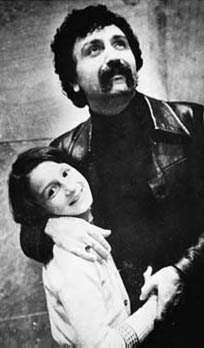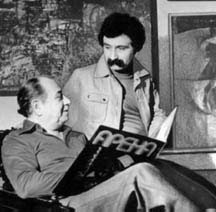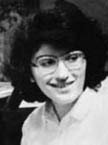|

Winter 1997 (5.4)
Pages
72-75
The Emergence
of Jazz in Azerbaijan
Vagif
Mustafazade: Fusing Jazz with Mugam
by Vagif
Samadoglu
Music samples
Related articles
1 All
Eyes on Aziza - Catching up with Azerbaijan's Famous Jazz Artist
- Aziza with Betty Blair
2 Aziza Mustafa
Zadeh - Jazz, Mugam and Other Essentials of My Life - Aziza
Mustafa Zadeh with Betty Blair
  Before
the turn of the 19th century, Baku was already known for its
oil. Europeans gravitated to this city on the shores of the Caspian,
and together with local entrepreneurs, they succeeded in producing
more than 51 percent of the world's supply of oil. Before
the turn of the 19th century, Baku was already known for its
oil. Europeans gravitated to this city on the shores of the Caspian,
and together with local entrepreneurs, they succeeded in producing
more than 51 percent of the world's supply of oil.
Left: Aziza
and
her father, Vagif Mustafazade
At about the same time, America was giving birth to a new musical
form-jazz. This mesmerizing new sound which originated in the
restaurants and back alleys of New Orleans and Chicago drew upon
many different cultural traditions, including African rhythms,
Asian improvisations and abstract thinking, European classical
music and even symbols borrowed from Native American tribes.
Soon afterwards,
this new musical synthesis found its way to other cities all
over the world, including Baku. Newspaper archives indicate that
bands were performing jazz in Baku restaurants. It's very possible
that Robert Nobel and his brothers, Ludwig and Alfred, listened
to jazz in Baku. Unfortunately, there are no early recordings
to determine the professional quality of these performances.
But an ironic twist of fate brought this economic boom to an
abrupt stop. In 1920, the Soviet regime gained control of the
region, and soon Soviet doctrine profoundly affected all aspects
of life-even attitudes toward art, literature and emotions. Everything
was subject to Communist ideology and central control. Nothing
escaped its scrutiny, not even music - including what to sing,
what to play and what to listen to. These decisions were all
made in the Kremlin in Moscow - not by local artists.
Soviet Ban On Jazz
  But
in 1945 at the end of what the Soviets call the "Great Patriotic
War" (World War II), Stalin decided to prohibit jazz throughout
the Soviet Union, by labeling it "music of the capitalists."
Jazz had already been banned by Hitler in Germany in 1933 on
the grounds that it was "the music of blacks." But
in 1945 at the end of what the Soviets call the "Great Patriotic
War" (World War II), Stalin decided to prohibit jazz throughout
the Soviet Union, by labeling it "music of the capitalists."
Jazz had already been banned by Hitler in Germany in 1933 on
the grounds that it was "the music of blacks."
Left: Two of Azerbaijan's
great jazz pianists - Tofig Guliyev (seated) with Vagif Mustafazade.
Consequently, between 1945 and Stalin's death in 1953, not only
jazz, but even music played on the saxophone was prohibited.
It's a fact that during that period, the saxophone solo in Ravel's
famous "Bolero" was played on bassoon.
Such a ban could have been expected. Totalitarian regimes always
seem to be suspicious of artistic forms that are based on egalitarian
improvisation. Even today, jazz is usually not sanctioned in
countries ruled by dictatorial regimes.
Despite these prohibitions, by the 1950s, a new jazz movement
began to emerge in Azerbaijan which came to be known as "jazz
mugam" or "mugam jazz" (whichever term you prefer).
Its origins were in Baku; its brain child, Vagif Mustafazade.
Childhood Friendship
Vagif
was born in 1940 in a difficult period when our country did not
wear the smile of jazz on its face. But he went on to become
a shining star in the darkness and developed into an extraordinarily
great jazzman, pianist and composer.
Actually, I
can't quite remember the first time I met Vagif. It seems I've
always known him. It must have been in my early years at school.
He was a year younger than me. Later I discovered that his name,
as well as mine, had been chosen by my father, Samad Vurgun,
the renowned poet. His mother had asked my father to suggest
the name. "Vagif" is an Arabic word that means "extremely
knowledgeable."
  The
truth is that Vagif Mustafazade, himself, could have become a
poet. Not many people knew his verbal acuity. My family is fond
of reminiscing about the time when Vagif was only three years
old and recited from memory a section from my father's play,
"Farhad and Shirin." He had only heard the work once. The
truth is that Vagif Mustafazade, himself, could have become a
poet. Not many people knew his verbal acuity. My family is fond
of reminiscing about the time when Vagif was only three years
old and recited from memory a section from my father's play,
"Farhad and Shirin." He had only heard the work once.
Left:
Lala Mustafazade, classical
pianist.
I well remember the days when Vagif and I used to gather with
friends near Maiden's Tower or in Sabir Park and recite "meykhana"
(pronounced MEY-kha-na). "Meykhana" is a kind of rhythmic
poetry, somewhat like contemporary "rap" in the West.
It's a pity that none of those pieces were ever recorded. As
might have been expected, "meykhanas" were also prohibited
in Soviet Azerbaijan, simply because improvised forms of poetry
could not be controlled and censored. They were considered too
volatile. The totalitarian regime branded it as "hooligan
poetry." Well, it seems Vagif and I were among the "great
hooligans."
Listening Secretly
- BBC
Vagif
lived on a second-floor apartment in Ichari Shahar (the Inner
City), which has since been converted into the Vagif Mustafazade
Home Museum and can be visited today. The building was constructed
during the oil boom, but after the Soviets came, this place,
like hundreds of others, was savagely divided into small apartments.
The Mustafazades-Vagif and his mom, Ziver Khanum (Mrs. Ziver)-were
assigned one small room which served as both bedroom and living
room. Fortunately, it was bright and bathed in sunlight. They
shared a kitchen and bathroom with other occupants in the building.
Despite the impoverished setting, that single one-room apartment
became a repository of an immense musical knowledge and in shaping
the movement of jazz in Azerbaijan. I have so many fond memories
of times spent together there, including the endless hours we
used to listen secretly to the short wave radio programs of BBC
just to catch some of the jazz they broadcast. Neither of us
knew English.
Afterwards, we would try to reproduce the music that we had heard
on the old piano in the apartment. Radio BBC was our only exposure
to jazz at the time. Despite the fact that I had studied music
my entire life, it wasn't until the mid-1950s that I first laid
eyes on a jazz score. The only thing we could do was to listen
at every chance we got, and then try to imitate the sounds that
we heard. We didn't have access to personal tape recorders in
those days. Vagif was especially adept. He had an incredible
ear for music.
For example, once his piano teacher asked him to learn Rachmaninoff's
"Prelude in C-Sharp Minor." But he didn't have access
to the score, so he listened to the record several times and
that's how he learned to perform it.
On occasion, we would hear jazz excerpts at the movies. You could
always tell whenever an American spy was about to appear in a
scene in a Soviet movie. His entrance was signaled by jazz. After
World War II, we had access to a few American movies. Some had
jazz on their soundtracks.
Vagif and I used to watch these films at the cinema over and
over again, sometimes 20-30 times. We would wait for the sections
that had jazz, then rush back home to try to reproduce them while
they were still fresh in our minds. I remember that "Sad
Baby," a song in the film, "The Fate of an American
Soldier," always used to make us cry.
No Longer Outlawed
After
Stalin's death in 1953, the prohibition against jazz was gradually
lifted. Still, the public was highly suspicious. As could have
been expected, the situation didn't change overnight. For example
in 1957, Vagif was scheduled to give a concert at Music School
#1, where his mother taught piano. His program included two or
three short jazz compositions. But the concert was never allowed
to take place because the music was branded as "capitalist."
Therefore, Vagif and other musicians involved with jazz, mainly
performed in clubs and each others' homes. Classical jazz, including
dance music and "blues," formed the basis of Vagif's
repertoire. Early on, he created some magnificent renditions
of the Fox Trot, the Charleston and the One-Step, as well as
some memorable pieces from Glenn Miller's "Serenade of the
Sunny Valley."
After that, B-Bop came along. However, Vagif always had an affinity
for improvisational jazz. He didn't really understand why, but
he began living with this love and obsession. It was a mystery
to him why he was so attracted to it.
In 1958, he was selected as pianist for the Folk Instruments
Orchestra, and they performed several concerts at the Philharmonic
together. He continued to play dance jazz in clubs, but it was
clear that he was not comfortable. He was in search of something
else. He was unsettled and this quest tortured him morally, sometimes,
even physically. The fact that he couldn't expose his inner world
openly to his audience and that he was deprived of sharing his
feelings with people freelygnawed at him. That's when he started
drinking and getting involved with drugs.
The words of his critics didn't help any either. Their opinions
often contradicted one other. Sometimes they praised him; other
times, they brutally criticized him.
Jazz Mugam is Born
Eventually,
Vagif created a new sound-his own kind of jazz-a fusion of jazz
with a form of music indigenous to Azerbaijan-the mugam. Essentially,
Vagif Mustafazade's jazz was the first to be built upon the native
music of the East. Such a trend was not new. Azerbaijan was used
to being "first" when it came to music in the Muslim
East. For example, Azerbaijan lays claim to the first opera,
the first female opera singer, the first ballet and the first
symphony orchestra.
Mugam jazz is jazz based on the modal forms or scales of mugams,
just as a mugam symphonies are symphonies based on mugams. Ordinary
jazz is marked by metered rhythm. But mugam jazz does not follow
a metered system. Both rhythm and scales are improvised.
By the beginning of the early 1960s, Vagif was gaining recognition
outside of Azerbaijan as a jazz musician. In 1966, Willis Conover,
conductor of the "Jazz Time" radio program, announced,
"Vagif Mustafazade is an extraordinary pianist. It is impossible
to identify his equal. He is the most lyrical pianist I have
ever known."
That year, Conover came to the Jazz Festival in Tallinn, Estonia,
after visiting several European countries. He expressed his disappointment
with the American jazz he had heard there and complained that
"no one can play American jazz like Americans do."
When the participants heard this, most of them changed their
programs and concentrated more on their own "national"
pieces. Everybody expected Vagif to do the same and play one
of his mugam-jazz arrangements. But instead, he challenged Conover
and surprised everyone by playing Gershwin's "The Man I
Love." As he finished the piece, Conover stood, applauding
and shouting "Bravo!" Vagif had proved that he could
play American jazz, as well as, and possibly even better than,
most Americans. He took first place at the festival.
Despite this worldwide recognition, Vagif still had trouble finding
support at home. Some of his friends, including myself, who taught
at the Music Conservatory (now known as the Music Academy), were
unable to secure a position for him there. Decision makers always
complained that he was too involved with jazz. It wasn't until
1964 that he acquired a position, thanks to the efforts of Rafig
Guliyev and Zohrab Adigozalzade, who both taught there.
Aziza is Born
Then
Vagif left for the Republic of Georgia where he organized the
famous "Orera" group and helped train famous musicians
such as Tomaz Kurashvili. It was also in Georgia that he met
a young woman, Elsa, whom he later married. Vagif already had
a daughter by his first marriage by the name of Laleh who would
grow up to become an extraordinarily talented classical pianist
and would win the Grand Prize for Piano in Epinal, France, in
1991.
Then a daughter was born to Elsa, and they named her, Aziza.
Now in her late 20s, she has became one of the stars of jazz
music, just like her father was. In 1978 Vagif took first place
for his performance of "Waiting for Aziza," at the
8th International Jazz Festival in Monaco.
Other jazz pianists had a great respect for Mustafazade. Once,
when Vagif was playing in the Iveriya Hotel in Tbilisi, the famous
American jazz pianist and master of blues, B. B. King, heard
him and remarked, "Mr. Mustafazade, they call me the 'King
of the Blues,' but I sure wish I could play the blues as well
as you do."
Vagif's Death
Vagif's
death was a shock to many people. He was only 39 years old when
he died on stage while performing in Tashkent (Uzbekistan) in
December 1979. Somehow the tragedy came as no surprise to me.
I had, somehow, anticipated it. Every time I used to see him
at the piano, I realized that he was as taut as a string. I knew
that he would not be able to survive music for very long.
Three months later, on March 16, 1980, I helped to organize a
Memorial Night at the Actors' House devoted to his memory. So
many people came to pay tribute that we had to set up loudspeakers
in the lobby and in the street. There just wasn't enough room
in the hall. A few days later Conover devoted his 45-minute radio
program entirely to Vagif.
Vagif's mother spent the last years of her life officially seeking
permission to convert their apartment into a home museum in honor
of her son. She managed to remodel the area and gain access for
the museum to two additional rooms adjacent to the original quarters
where they had once lived. The Vagif Mustafazade Home Museum
was opened on March 1, 1988, eight years after Vagif's death.
Eight years later, in January 1996, Ziver Khanum, too, also passed
on.
The museum is open to the public-this apartment where Vagif,
I and others spent so many intense, pleasurable hours and days
straining to hear Radio BBC and experimenting and improvising
on the piano.
It's a very simple museum. Lots of photos are on the walls. The
piano is still there in the main room, as is the old wooden box
radio.
It's amazing how those jazz programs that we listened to some
30-40 years ago were able to penetrate the stubborn walls of
totalitarianism, and how the sound that eventually emerged still
affects how jazz is played in Azerbaijan today.
Vagif Samadoglu,
the author of this article, is the son of the famous poet Samad
Vurgun. He studied classical music professionally and graduated
from the Academy of Music and graduate studies at the Moscow
Conservatory. He won the 1962 Music Festival in Baku. He now
devotes all his time to writing poetry. His most recent book,"Man
vurdayam" (I Am Here), was published in Baku in 1996 (Azeri
Cyrillic). See AI 4.1, Spring 1996, for Vagif's article about
his father, Samad Vurgun.
Vagif Mustafazade's Home Museum is located in the Inner City
(Ichari Shahar) at Duksovski Corner, Vagif Mustafazade Corner
4. Tel: (99-412) 92-17-92.
From
Azerbaijan
International
(5.4) Winter 1997
© Azerbaijan International 1997. All Rights Reserved.
Back to Index AI 5.4 (Winter
1997)
AI Home |
Magazine
Choice
| Topics
| Store
| Contact
us
|



